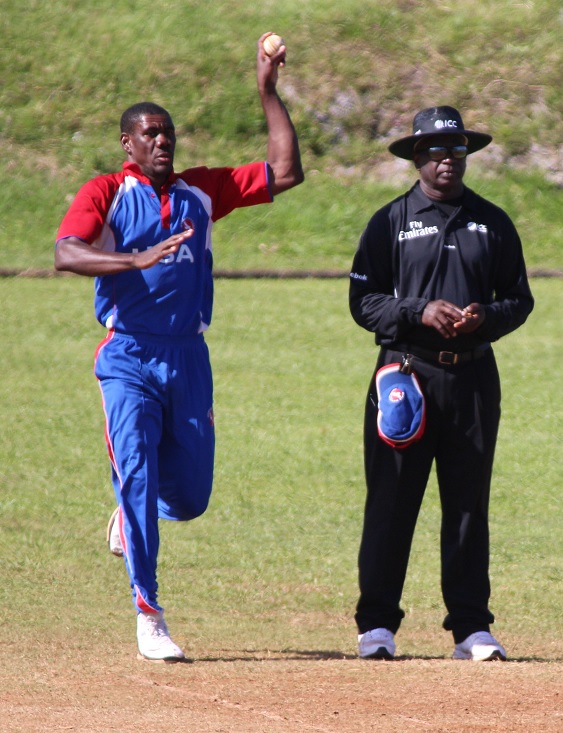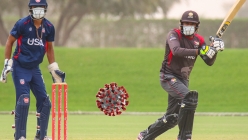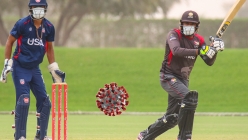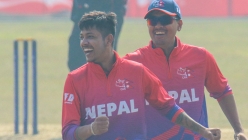USA Cricket: 2013 ICC WCL Division Three Report Card Part 1 - Team Grades
2013 May 10 by DreamCricket USA
If Sushil Nadkarni is USA's best player and best opener, it stands to reason that he should have been opening throughout the tournament but he never opened the batting once for USA and that hurt them in the end.
Now, you can get all the USA Cricket updates via Facebook. Also follow us on Twitter via @dreamcricket
By Peter Della Penna (on Twitter)
Part 1 - Team Grades
Batting – C+: USA had the tournament’s highest scorer after the group stage and overall in Steven Taylor. They also had eight of the 12 highest partnerships in the tournament, with two century stands and seven half-century stands overall. Unfortunately, USA’s batting lacked the overall consistency from the beginning to the end of the tournament as well as from the top to the bottom of the order.
.jpg) The team scored one century and eight half-centuries, but also compiled eight ducks. The first wicket partnership of Taylor and Orlando Baker produced 125 runs on the first day, USA’s best ever partnership against Nepal, but after that the first wicket partnership averaged just 6.20 the rest of the tournament.
The team scored one century and eight half-centuries, but also compiled eight ducks. The first wicket partnership of Taylor and Orlando Baker produced 125 runs on the first day, USA’s best ever partnership against Nepal, but after that the first wicket partnership averaged just 6.20 the rest of the tournament.
Image (left) - Steven Taylor acknowledges his USA teammates after reaching 100 against Nepal on the opening day of the tournament. [Courtesy: Peter Della Penna/DreamCricket.com]
USA’s best opening tandem in 50-over cricket is Taylor and Sushil Nadkarni. Although USA has had a long established strategy of slotting Nadkarni down the order against Nepal, there was no reason why he should not have been opening in the other matches he played. USA coach Thiru Kumaran stated after Nadkarni missed the crucial round-robin showdown against Bermuda that, “Sushil getting injured and not coming in, maybe that could have affected us a little bit. Being an important game, we didn’t have our best player, our best opener there.”
If Nadkarni is USA’s best player and best opener, it stands to reason that he should have been opening throughout the tournament but he never opened the batting once for USA and that hurt them in the end. The most surprising pair sent out to open was Japen Patel with Taylor against Uganda. Patel is a player who has shown some improvement with his batting and USA’s administration is eager for him to develop, but he has no business batting above Nadkarni under any circumstances, let alone open above him.
USA’s best partnerships of the tournament came for the third wicket where they averaged 71.83. Baker and Taylor produced USA’s best partnership from that spot in the third place game, 156 runs against Bermuda. USA also had half-century stands for the third wicket against Nepal (Taylor and Nadkarni), Italy (Massiah and Nadkarni) and against Bermuda in the last round-robin game (Baker and Dodson).
USA’s middle to lower order partnerships were strong when the pressure was off in the third place game against Bermuda and after a huge platform had been set against Nepal, but otherwise the segment of the game where Aditya Thyagarajan usually specializes in fell apart for USA in his absence. They averaged 14.17 for the fifth wicket and 6.83 for the sixth wicket in the tournament. USA put up a 93-run unbeaten stand for the seventh wicket against Nepal, but in the other four group games they averaged 12.50 for the seventh wicket. Thyagarajan’s ability to put together partnerships in the middle and lower order was sorely missed especially against Oman, Uganda and Bermuda.
Worst of all was the cardinal sin committed by not batting out all 50 overs against Uganda. It cost USA by the end of the tournament when the net run rate tiebreaker came into play. The team shot themselves in the foot multiple times in that match with foolish shots to get out and displayed an inability to rotate the strike. The game plan appeared to be for batsmen to slog their way out of trouble or get out doing it. Uganda scored 92 runs off ones and twos in that match while USA could only manage 36 runs off singles and doubles. No matter how difficult the pitch was in the second innings, that’s poor.
Overall, USA benefitted greatly from missed chances by their opponents. The tournament could have turned out much worse for USA had they not had such good fortune at the crease, although USA more than repaid it in the field against Bermuda. Opponents committed less drops than USA in the field, but USA punished their opponents more for each drop. USA's opponents conceded 14 missed chances during the group stage, but USA seized an extra 354 runs off the misses. Four times a USA batsman finished not out after being dropped. After the first time a batsman was dropped, USA averaged 44.25 extra runs. The most valuable second chance USA had during the group stage was when Oman goofed up a runout opportunity when Rashard Marshall was on 12. The bowler dislodged the bails without the ball in his hand and Marshall went on to win the match for USA by making 72 not out in a two-wicket win.
 Bowling – B: USA’s bowling unit performed well for most of the tournament with their only glaring letdown coming during the Christopher Douglas ambush in the last group match against Bermuda. USA allowed just three half-centuries during the tournament, but allowed eight half-century stands during the event, including two in that crucial match against Bermuda. Neil McGarrell was tied for first atop the wickets list after the group stage with 12.
Bowling – B: USA’s bowling unit performed well for most of the tournament with their only glaring letdown coming during the Christopher Douglas ambush in the last group match against Bermuda. USA allowed just three half-centuries during the tournament, but allowed eight half-century stands during the event, including two in that crucial match against Bermuda. Neil McGarrell was tied for first atop the wickets list after the group stage with 12.
Image (right) - USA fast bowler Elmore Hutchinson on his approach to the crease. Hutchinson finished second on the team with 10 wickets in the tournament. [Courtesy: Peter Della Penna/DreamCricket.com]
USA’s opening bowlers were good at making early breakthroughs. The opposition averaged 13.50 for the first wicket and twice the opposition lost their first wicket without scoring. But the biggest opening stand came at the worst possible time for USA, 43 by Bermuda in their upset win on the last day of round-robin play. The opposition’s best partnerships were for the fourth wicket with an average stand of 37.00 including two-half century stands produced by Bermuda and Uganda. Each of those stands could have been curtailed had USA converted catching or runout opportunities provided to them in the field.
USA also lacked a killer instinct to wipe out the tail, something they have struggled with in the past, as Steve Massiah’s preferred method of captaincy is to let a match drag on rather than go for the kill. As a result, the ninth wicket stand for the opposition averaged 27.40. Noteworthy partnerships of 44 and 41 were produced by Nepal and Oman, something that turned out to be crucial by the end of the tournament when the net run rate tiebreaker came into play.
Fielding – F: USA missed 24 definite chances in the tournament (19 drops and five missed runouts), an average of four per game, while numerous other runout half-chances were missed in the field. Many teams have varied levels of batting and bowling skills, but the two things that every international side can do to narrow any gap against their opponent is to outwork them with fitness and fielding. USA always lags behind in both areas and it keeps their opponents in games.
USA had 19 missed chances during the group stage with the chances coming off 10 batsmen. On six occasions in the group stage, USA gave the same player multiple lives and on three of those occasions they dropped a player three times in one innings. After a batsman’s first missed chance, USA gave up an average of 24.33 extra runs to that player during the group stage, conceding a total of 219 runs overall after missed chances in their first five games. On average, USA conceded an extra 36.50 runs per game in the group stage on missed chances.
The costliest miss came against Nepal, when number seven batsman Sharad Vesawkar was dropped on 0, the first of three extra lives he was given, and made 72. USA’s fielding was horrendous against Bermuda, with six definite missed chances and many more half-chance runout opportunities lost. At 2012 ICC WCL Division Four in Malaysia, Singapore began a frantic chase on the last day against USA by stealing sharp singles at will in the first nine overs. A direct hit by Ryan Corns in the 10th over put Singapore on notice that they could no longer keep challenging USA in the field the way they had been and suddenly the pressure shifted onto Singapore as USA strangled the scoring rate.
All it would have taken was a single runout in the first 15-20 overs to put off Bermuda from stealing those sharp singles at the National Stadium on the final day of round-robin play in Hamilton. USA’s fielders did not score a direct hit the entire afternoon, whether or not a batsman had his bat across the line, and on multiple occasions fielders panicked under pressure by choosing the wrong end to throw to. Many other opportunities could have been converted with an accurate throw to wicketkeeper Akeem Dodson over the stumps. Instead, throws short-hopped into his feet or were wide enough of the stumps that he had to dive just to save them from turning into extra runs on overthrows. USA finally converted a run out in the 35th over, by which time Bermuda had run away with the match. Bermuda reached the target in the 45th.
Fitness – C-: USA’s fitness was good in the early stages of the tournament, but flagged as the tournament continued and was a contributing factor in their losses to Uganda and Bermuda. Taylor was well conditioned at the start of the tournament and his 162 against Nepal was chanceless.
However, he appeared to be weighed down by wicketkeeping on top of opening the batting as the event wore on. The team’s flagging fitness had a definite impact against Bermuda with so many sloppy fumbles, misfields, misfired throws and drops. It’s not as if Bermuda’s fitness was much better with two batsmen, Douglas and Stephen Outerbridge, struggling through their innings while cramping up. Yet they managed to find a way past it while USA was hampered.
USA will have plenty of time to work on their fitness though. By finishing out of the top two in Bermuda, their next 50-over ICC tournament won’t be for another two years.
Coming up in Part 2 - Player Grades
[Views expressed in this article are those of the author who was present at all of the team's matches. If you have differing views or opinions, we respect those views and urge you to provide your feedback - both positive and negative - in the comments section.]




